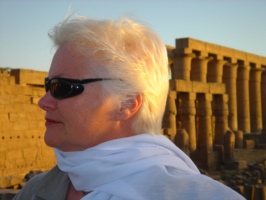The best introduction to Paris on a clear day is from the second etage (“floor”) of the great symbol of the city, La Tour Eiffel (“the Eiffel Tower”). Though I took the elevator to le sommet (“the summit”) the other day, I could only see structures and hills very far away from the central city. My advice is to stick with the second floor for viewing the boulevards, churches, trees, the Seine River, and parks as though you were a gliding pigeon.
(Continued)
I look for the quiet Paris.
(Continued)
Sunday, September 30, 2007
1) I had never been to a full ballet; 2) Emily Bronte’s Wuthering Heights is my favorite book (well, maybe with the last section lopped off); 3) Heathcliff desperately calls out, “Cathy! Cathy, my heart’s darling!”;Â 4)Â The Opera is a half-hour walk from my apartment; and, 5) my ticket was only 10 euros.
How could I not respond to the poster for the ballet Hurlevent (“roaring wind”), advertised as Wuthering Heights?. The ballet production was choreographed by Kader Belarbi, a dancer of Algerian origin.
(Continued)
Saturday, September 29, 2007
Walking through Paris, I see many specialty shops sprinkled among the supermarches (supermarkets), clothing stores, restaurants, and bars. You need to know the kind of store you’re walking into, though, and what names will lead you to what you’re looking for. You don’t want to walk into a charcuterie if you’re looking for a screwdriver. Here are a few French store names, all feminine nouns, to keep handy in your brain.
(Continued)
Friday, September 28, 2007
Last week I visited the Louvre, the palatial art behemoth sprawling on the right bank of the Seine. The Mona Lisa, Winged Victory of Samothrace, and Venus di Milo may be the Louvre’s most popular artworks, but there is another masterpiece that puts me in absolute awe: Theodore Gericault’s Le Radeau de la Meduse (The Raft of the Medusa). The Raft’s size, story, and style are truly astonishing.
(Continued)
Thursday, September 27, 2007
Scarves in Paris. Thin and casually hanging from a simple foldover over the jacket. Thick and folded in blousy knots just under the chin. Silky shine, flower and bird patterns, paisley prints, “Paris” in cursive writing, Arabian stripes. Scarves fluttering and whipping around in the wind at the stalls along the Seine. Magenta, turquoise, orange, olive, silver, and red ones on the women. Simple black, gray, and khaki scarves on the businessmen. Scarves, scarves, scarves.
(Continued)
Wednesday, September 26, 2007
Last Friday my friend and I toured the Memorial du la Deportation on the eastern tip of Ile de la Cite. The small, stark memorial honors the 200,000 French Jews, resistance fighters, and forced laborers who died in Nazi concentration camps during World War II. Containers of dirt and ashes from each of the camps line the memorial’s walls. It’s a place that inspires silence and reflection, quite a contrast to the festive, noisy park just above.
(Continued)
Tuesday, September 25, 2007
There are many French words that mean nearly or exactly the same thing in English, though the spellings and pronunciations are a bit different. Here are some French words starting with the letter A, listed without accent marks. I am sure you will be as astounded at the number as I was.
abandon, abdication, abdomen, aberration, abject, abnegation, abominable, abstinence, absurd, academician, accent, accessible, accident, acclimation, acid, acoustique, action, addition, adequat, adherence, adjacent, adjuration, administrateur, admirable, adolescence, adorable, affair, affiliation, affliction.
(Continued)
Monday, September 24, 2007
My apartment is in the second arrondissement, one of the 20 “districts” of Paris. Thirza Valloisis, author of Around and About Paris, Volume I, II, III, gives us a taste of the 2nd’s history below (with some editing by me).
*****
The 2nd arrondissement drew in the most destitute segments of society between the 15th and 17th centuries, when the Hundred Years’ War and the Black Plague had much of the population homeless and starving. Deserting the countryside, they made their way into the capital.
(Continued)
Sunday, September 23, 2007
Though my personal disdain for buskers in general and mimes in particular is well known, it was very sad to hear of the death in Paris today of Marcel Marceau. Especially in light of Yom Kippur this weekend, his death was especially poignant. A Jew who hid his identity with the adopted last name of Marceau, Marcel lived some of the sad history and artistic life of France.Â
(Continued)
